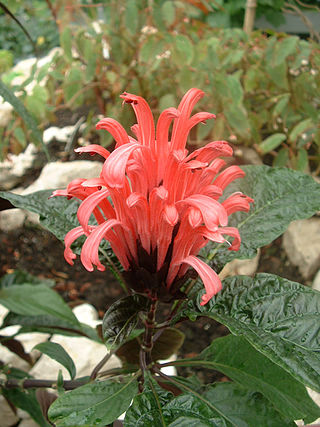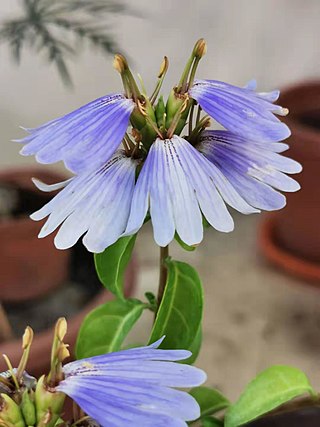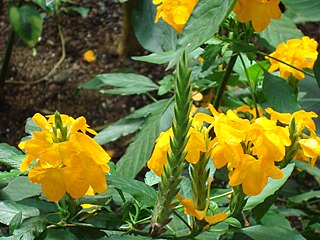
Acanthaceae is a family of dicotyledonous flowering plants containing almost 250 genera and about 2500 species. Most are tropical herbs, shrubs, or twining vines; some are epiphytes. Only a few species are distributed in temperate regions. The four main centres of distribution are Indonesia and Malaysia, Africa, Brazil, and Central America. Representatives of the family can be found in nearly every habitat, including dense or open forests, scrublands, wet fields and valleys, sea coast and marine areas, swamps, and mangrove forests.

Justicia is a genus of flowering plants in the family Acanthaceae. It is the largest genus within the family, encompassing around 700 species with hundreds more as yet unresolved. They are native to tropical to warm temperate regions of the Americas, India, and Africa. The genus serves as host to many butterfly species, such as Anartia fatima. Common names include water-willow and shrimp plant, the latter from the inflorescences, which resemble a shrimp in some species. The generic name honours Scottish horticulturist James Justice (1698–1763). They are closely related to Pachystachys.

Anisacanthus is a genus of flowering plants in the bear's breeches family, Acanthaceae. The generic name is derived from the Greek words ανισος (anisos), meaning "unequal," and ακανθος (acanthos), meaning "thorn." Members of the genus are native to tropical and subtropical regions of the Americas. They are commonly known as desert honeysuckles, though this term is shared with the genus Ancistranthus, and is something of a misnomer as true honeysuckles belong to the family Caprifoliaceae. Anisacanthus species are sometimes cultivated for use in xeriscaping.
Gustav Lindau, was a German mycologist and botanist.
Acanthopale is a plant genus of shrubs or subshrubs in the Acanthaceae plant family. The genus name is based on the classic Greek words for thorn ákantha and stake palum. Some species in the genus are cultivated as ornamental plants.

Anisotes is a genus of Afrotropical plants in the family Acanthaceae. The genus is morphologically similar to Metarungia, from which it differs mainly in the dehiscence of the fruit capsule, and the nature of the placenta. Placentas remain attached to the inner surface of fruit capsules in Anisotes.

Sclerochiton is a genus of plants in the family Acanthaceae.

Crossandra is a genus of plants in the family Acanthaceae, comprising 54 species that occur in Africa, Madagascar, Arabia and the Indian subcontinent. Some species, especially Crossandra infundibuliformis, are cultivated for their brightly colored flowers.
Satanocrater is a small genus of flowering plants in the family Acanthaceae, disjunctly distributed in Guinea in west Africa, and Ethiopia, Kenya, Somalia and Sudan in east Africa. They are xerophytes, and either shrubs or perennial herbs.
Xantheranthemum, known as the golden vein plant or bronze vein plant, is a genus of flowering plants in the family Acanthaceae. It has only one currently accepted species, Xantheranthemum igneum, native to Peru. It is grown as a greenhouse or house plant. There may be some confusion caused by the names of the botanists Linden and Lindau, as some sources associate it with Aphelandra goodspeediiStandl. & F.A.Barkley, along with Chamaeranthemum igneumRegel, Eranthemum igneumLinden, Stenandrium igneum(Linden) André, Stenandrium pictumN.E.Br., and Xantheranthemum igneum(Linden) Lindau.
Cephalacanthus is a genus of flowering plants belonging to the family Acanthaceae.
Chalarothyrsus is a genus of flowering plants belonging to the family Acanthaceae.
Chlamydacanthus is a genus of flowering plants belonging to the family Acanthaceae.
Chlamydocardia is a genus of flowering plants belonging to the family Acanthaceae.
Jadunia is a genus of flowering plants belonging to the family Acanthaceae.
Dichazothece is a genus of flowering plants belonging to the family Acanthaceae.
Duosperma is a genus of flowering plants belonging to the family Acanthaceae.
Heteradelphia is a genus of flowering plants belonging to the family Acanthaceae.
Kosmosiphon is a genus of flowering plants belonging to the family Acanthaceae.
Megalochlamys is a genus of flowering plants belonging to the family Acanthaceae.





